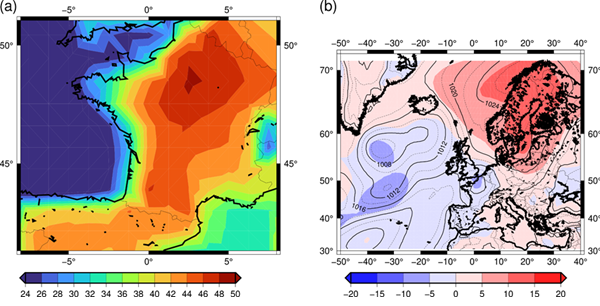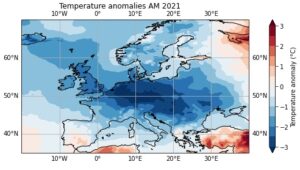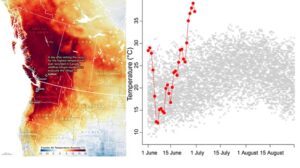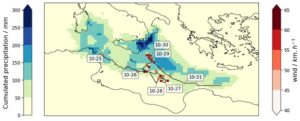SCENARIO OF AN EXTREME HEAT: PARIS 50°C TO SUMMER OLYMPICS HEATWAVE
The 2024 Summer Olympic Games took place during the hottest part of the year in the Paris area, and raised the question how hot heatwaves over Paris could be in the near future. In recent years, the mid-latitudes of the Northern Hemisphere have experienced several intense heatwaves since the major one in 2003. These heatwaves have caused unexpected environmental and health problems. In addition, the questions arose whether, when and in what condition temperatures could exceed 50°C in Paris at the 2100 horizon, and thus what the city of Paris needed to be prepared for.

Figure1: Reaching 50°C in Paris and associated atmospheric circulation. Maximum daily temperature (TX) over France (panel a) and SLP over the North Atlantic (panel b) on 27 July 2077, for CMCC-ESM2, in SSP2-4.5 (r1i1p1f1). TX (panel a) is expressed in °C. SLP is expressed in hPa (isolines in panel b). Colors in panel (b) correspond to anomalies of SLP (in hPa) with respect to the summer average. From Yiou et al. (2024).
Event definition
A first event definition that is considered is motivated by the duration of Olympic games: the warmest period of 15 days in July-August (TG15d) in Ile-de-France in July-August, for each year (TG15d). A second question that will be considered is whether and for how long temperatures of 50ºC can be exceeded in Paris. Next, we question how high temperatures over Paris, as well as the region surrounding Paris, could potentially become in worst case scenarios.
Objectives
XAIDA aims at improving the understanding of what temperatures Paris and the surrounding region may need to be prepared for in the (near) future. Knowing answers to questions like: « what are maximum possible temperatures at present? », or « By when will it be possible to reach temperatures of 50ºC before 2100, depending on emission scenarios? » before an extreme temperature event happens will raise awareness. This in turn will help health, transportation and safety authorities to avoid domino effects in case of a climate crisis. We answer these questions using both ensemble boosting, analogues and data mining.
Study results
Yiou et al. (2023) look for the most extreme heatwaves that could realistically happen in the Île-de-France region under climate change scenarios around the 2024 Olympics. To overcome the challenge of rare events, they use a rare event algorithm on CMIP6 climate data to explore possible extremes. Their findings show that the 2003 heatwave record could be surpassed by over 4°C in Île-de-France before 2050, driven by a mix of high-pressure anticyclonic conditions and isolated low-pressure systems.
Yiou et al. (2024) explore two questions posed by the City of Paris: 1.) When are extreme heat events likely to occur? and 2) What weather conditions lead to them? They use data from CMIP6 climate models, which often have temperature biases. Instead of applying bias corrections (which may not work well for extreme events), they take a practical approach by selecting models that can realistically simulate such high-temperature events. They examine the weather patterns that lead to these first occurrences of extreme heat and identify common atmospheric conditions. The study uses a simple data-mining method on a large set of climate simulations, which could also be applied to other regions. The study concluded that extremely high temperatures can only happen if global surface temperature rises by more than 2°C. Some climate models predict this could happen by around 2050. They furthermore studied the weather patterns that lead to these extreme temperatures.
Fischer et al. (2023) demonstrate that an ensemble boosting approach can be used to generate physically plausible storylines of a heatwave. They found that week-long heatwaves far more intense than anything experienced before could happen in places like the Paris region. In a second study focusing on longer time scales the same approach was used to demonstrate that even extreme heatwaves lasting several weeks are plausible in the Paris region. The result based on ensemble boosting are consistent with subseasonal and seasonal forecasts of the past decades (Lüthi et al. 2025, in review). The drivers associated with these unprecedented heatwaves are consistent yet more intense than in observed heatwaves. To ensure confidence in these rare, « black swan »-type events, we need to combine different types of evidence with a clear understanding of the processes involved. This helps make the information reliable and useful for decision-makers.
Noyelle et al. (2023) in turn studied the highest possible temperatures in Western Europe, analysing the record-breaking July 2019 heatwave with flow analogues as an example. By analyzing similar weather patterns, they found that temperatures above 50°C could happen in many urban areas, even with today’s climate. They also compared the highest surface air temperatures from the past (1940–1980) to the present (1981–2021). The findings show that while daily maximum temperatures have increased significantly, this is not fully explained by a rise in the highest possible temperatures. Instead, most of the warming comes from stronger heat transfers at the Earth’s surface rather than warming higher up in the atmosphere.
Conclusion
Temperatures are rising and record temperatures are being reached. In order to be prepared for future « extreme events » we need to combine different types of evidence and communicate this to raise awareness in advance. Tools such as the one used for the Paris city (Paris 50°C: https://github.com/pascalyiou/Paris50C.git) could be extended to other areas of the world and operationalised.
References
Fischer E. M., Beyerle U., Bloin-Wibe L., Gessner C., Humphrey V., Lehner F., Pendergrass A. G., Sippel S., Zeder J. and Knutti R.: “Storylines for unprecedented heatwaves based on ensemble boosting”, Nature Communications, 14, 4643 (2023) https://doi.org/10.1038/s41467-023-40112-4
Lüthi, S., Huber, V., Pascal, M., Beyerle, U., Pyrina, M., Domeisen, D.I., Vicedo-Cabrera, A.M. and Fischer, E.M., Storylines for month-long heatwaves and associated heat-related mortality impacts over Western Europe. (2025) in review, preprint available at https://assets-eu.researchsquare.com/files/rs-5356341/v1_covered_47e6e9b3-a60a-4adf-81e2-dbdd70541905.pdf
Noyelle, R., Zhang, Y., Yiou, P. and Faranda, D, 2023: Maximal reachable temperatures for Western Europe in current climate, Environ. Res. Lett. 18 094061, https://iopscience.iop.org/article/10.1088/1748-9326/acf679
Yiou P., Cadiou C., Faranda D., Jézéquel A., Malhomme N., Miloshevich G., Noyelle R., Pons F., Robin Y. and Vrac M.: “Ensembles of climate simulations to anticipate worst case heatwaves during the Paris 2024 Olympics“, npj Clim Atmos Sci, 6, 188 (2023) https://doi.org/10.1038/s41612-023-00500-5
Yiou, P., R. Vautard, Y. Robin, N. de Noblet-Ducoudré, F. D’Andrea, and R. Noyelle, 2024: How could 50 °C be reached in Paris: Analyzing the CMIP6 ensemble to design storylines for adaptation. Climate Services, 36, 100518, https://doi.org/10.1016/j.cliser.2024.100518.
 This project has received funding from the European Union’s Horizon 2020 research and innovation programme under grant agreement No 101003469.
This project has received funding from the European Union’s Horizon 2020 research and innovation programme under grant agreement No 101003469.



